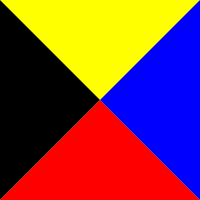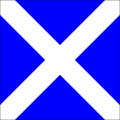Racing Rules of Sailing

The Racing Rules of Sailing (often abbreviated to RRS) govern the conduct of yacht racing, windsurfing, kitesurfing, model boat racing, dinghy racing and virtually any other form of racing around a course with more than one vessel while powered by the wind. A new revision is published every four years (after the Olympic Games) by World Sailing, the sport's world governing body. Full information on the rules [1] can be downloaded at World Sailing.
1997 saw the most dramatic simplification to the Racing Rules of Sailing since the 1940s. They are based on four main right of way rules: [Part 2, Section A]
- Boats on a port tack shall keep clear of boats on starboard tack (Rule 10).
- When boats are on the same tack and overlapped, the boat to windward (the boat closest to the wind) shall keep clear of a leeward boat (Rule 11).
- When boats are on the same tack and not overlapped, the boat that is astern shall keep clear of the boat ahead. (Rule 12).
- When a boat is tacking (changing tack) it shall keep clear of boats that are not tacking (Rule 13).
Four rules about general limitations: [Part 2, Section B]
- Even if you have right-of-way, it is your duty to avoid a collision, once it becomes apparent that the other boat is not keeping clear (Rule 14).
- If you acquire right of way, you must initially give the other boat room to keep clear, unless you get right of way because of the other boat's actions. (Rule 15)
- A boat that changes course, even if it has the right-of-way, shall do so in a manner that gives the burdened boat a chance to "keep clear" (Rule 16).
- If you catch up with another boat and you want to pass it to leeward, you may not sail above your proper course i.e. you shall not luff higher than you would have done if that boat wasn't there (Rule 17)
Three rules about marks and obstructions [Part 2, Section C] plus some other rules about starting errors, taking penalties, moving astern, when you are capsized or anchored or run aground, and interfering with another boat.
In total there are 91 rules but (since the major simplification in 1997) only 15 rules govern what boats do when they meet on the water (part 2 rules). It is not necessary to know all of the rules to successfully compete in a dinghy race, but a knowledge of the basics is recommended.
Sailboat racing is a self-regulated sport. As stated by the Racing Rules of Sailing, "Competitors in the sport of sailing are governed by a body of rules that they are expected to follow and enforce. A fundamental principle of sportsmanship is that when competitors break a rule they will promptly take a penalty, which may be to retire.".[2]
Depending on the nature of the infraction, the penalty may be either: (1) performing a turn consisting of one tack and one gybe or (2) performing two turns consisting of two tacks and two gybes (except for windsurfing).
For most rules infractions, a competitor may be absolved from disqualification from the race by taking such a penalty. However, if the infraction caused injury or serious damage, or produced a significant advantage in the race or series, the penalty shall be to retire. If a competitor fails to take penalty turn(s) they may be disqualified after a hearing by the Protest Committee. The aforementioned principles do not apply to match racing (like the America's Cup) where on-the-water umpires impose penalties immediately after an infraction occurs.
Race signals
Sail races are governed with flags and sound signals to indicate flag changes. The flags used are taken from the International maritime signal flag set. During a race and for any signal concerning the race, these flags are defined in the Racing Rules of Sailing but the signal can be modified by the Sailing Instructions.
The raising (hoisting) or removing of a visual signal is accompanied by the emission of a sound signal to draw attention to the new signal. The type of the sound signal (one short sound, two short sounds, one long sound, etc.) is described by the rule according to the type of signal. The usual meanings of these flags are as follows:
Postponement signal
The Answering Pennant (AP) with or without a numerical pennant is used to indicate a postponed race. A numerical pennant below the AP denotes the time, in hours, of the race postponement.
| Flag signal | Number of sound signals when raised | Number of sound signals when lowered | Description | |
| |
AP | |
|
Races not yet started are postponed. |
| |
AP 1 |
|
|
Races not yet started are postponed 1 hour. |
| |
AP 2 |
|
|
Races not yet started are postponed 2 hours. |
| |
AP 3 |
|
|
Races not yet started are postponed 3 hours. |
 |
AP A |
|
Races not yet started are postponed. No more racing today. | |
 |
AP H |
|
Races not yet started are postponed. More information ashore. | |
Preparatory signal
These signal flags are used before a race start and most commonly as part of a start sequence/procedure.
| Flag signal | Number of sound signals when raised | Number of sound signals when lowered | Description | |
 |
P | |
|
Normal preparatory signal - no starting penalties are in effect. A boat over the line at the start can return through the line or round an end but must keep clear of boats not returning. If they fail to return through the line however they will be scored OCS |
 |
I | |
|
The Round-an-End Rule 30.1 will be in effect. A boat over the line during the minute before the start must sail to the pre-start side of the line around either end before starting. If they fail to do this they will be scored OCS |
 |
Z | |
|
The 20% Penalty Rule 30.2 will be in effect. A boat within the triangle formed by the ends of the line and the first mark during the minute before the start will receive a 20% scoring penalty. |
  |
I Z |
|
|
Both the I flag rule and the Z flag Rule will be in effect during the minute before the start. If they fail to round an end then they will be scored OCS |
| |
|
|
The Black Flag Rule 30.3 will be in effect. A boat within the triangle formed by the ends of the line and the first mark during the minute before the start will be disqualified without a hearing. (Renumbered to 30.4 in the 2017–2020 edition.) | |
 |
U | |
|
The U Flag Rule will be in effect. A boat within the triangle formed by the ends of the line and the first mark during the minute before the start will be disqualified without a hearing. If a restart or resail is called, the disqualification is rescinded, unlike the black-flag or Z-flag penalties. (Added to the 2017–2020 edition as rule 30.3; already frequently included in sailing instructions for specific regattas.) |
Start signal
These signal flags are used in the pre-start procedure. Class flags can be numeral pennants 1 ![]() , 2
, 2 ![]() , and 3
, and 3 ![]() however they can be substituted to avoid confusion with the postponement signals relating to a particular class.
however they can be substituted to avoid confusion with the postponement signals relating to a particular class.
| Flag signal | Number of sound signals when raised | Number of sound signals when lowered | Description | |
| |
1 ↑ | |
Warning Signal. 5 minutes to race start when class flag raised. | |
 |
1 P ↑ |
|
Preparatory signal. 4 minutes to start when P flag raised. Flag P used or if a starting penalty applies I, Z, Black flag or I over Z is used in place of P. | |
 |
1 P ↓ |
|
Preparatory signal. P flag removed 1 minute before start. Flag P used or if a starting penalty applies I, Z, Black flag or I over Z is used in place of P. | |
| |
1 ↓ | |
Start Signal. Race start when class flag removed. | |
Recall signal
| Flag signal | Number of sound signals when raised | Number of sound signals when lowered | Description | |
 |
X | |
Individual recall.
One or more boats did not start correctly and must return and do a proper start. The X flag is displayed until the earliest of the following: all boats over the line early have returned correctly, 4 minutes from the start or until one minute before the next start. (The sound signal is in addition to the start sound signal) | |
| |
1st Sub | |
|
General recall.
All boats are to return and then a new start sequence will begin. Signaled when there are unidentified boats over the line or subject to one of the starting penalties, or there has been an error in the starting procedure. The new warning signal for the recalled class will be made 1 minute after the 1st substitute is removed. (The two sound signals when the first substitute is displayed are in addition to the start sound signal) |
Course change signal
| Flag signal | Number of sound signals when raised | Number of sound signals when lowered | Description | |
 |
S | |
Shortened Course.
When displayed at a rounding mark the finish is between the nearby mark and the mast displaying the S flag. When displayed at a line that boats are required to cross at the end of each lap the finish is that line. When displayed at a gate the finish is between the gate marks. | |
 |
C | |
Course Change.
When displayed at a rounding mark, the position of the next mark has been changed. If the direction to the mark has changed it shall be indicated by displaying the new compass bearing or a green triangular flag (or board) for a change to starboard or a red rectangular flag (or board) for a change to port. If the length of the leg has changed then this shall be signalled by displaying a "-" if the leg will shorter or a "+" if the leg will be longer. Repeated sound signals should be made to draw attention to the signal. | |
Abandonment signal
| Flag signal | Number of sound signals when raised | Number of sound signals when lowered | Description | |
 |
N | |
|
All races that have started are abandoned. Return to starting area for a new start. The first warning signal will be made 1 minute after N is removed. |
  |
N A |
|
All races are abandoned. No more racing today. | |
  |
N H |
|
All races are abandoned. More information ashore. | |
Other signals
| Flag signal | Number of sound signals when raised | Number of sound signals when lowered | Description | |
 |
L | |
When displayed afloat means: Come within hail or follow this boat.
When displayed ashore means: A notice to competitors has been posted. | |
 |
M | |
Indicates a boat or an object displaying this signal replaces a missing mark.
Repeated sound signals should be made to draw attention to the signal. | |
 |
Y | |
All people on board should wear a personal life jacket or personal buoyancy. | |
| |
BLUE | When displayed the race committee boat is in position at the finishing line. | ||
See also
- Dinghy racing
- Sailing
- Tacking (sailing)
- Yacht racing
- International Regulations for Preventing Collisions at Sea
Notes
External links
- World Sailing - A Short History
- Racing Rules of Sailing
- Interactive & multilingual sailboat racing rules game
- A history of the Racing Rules